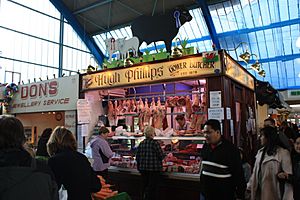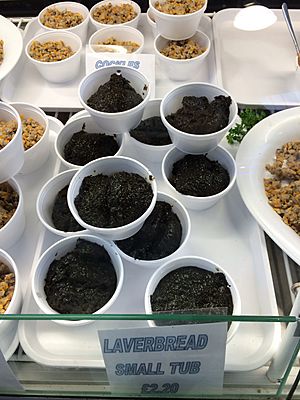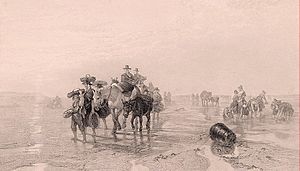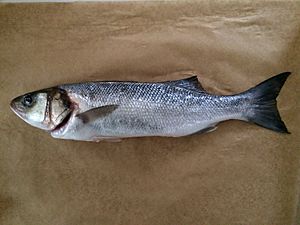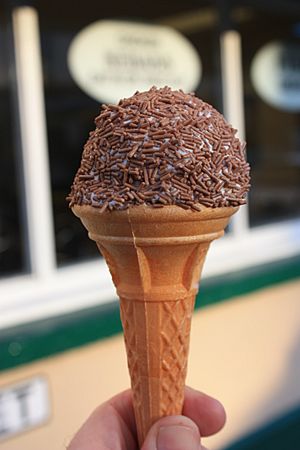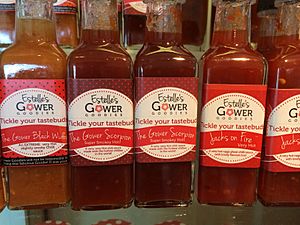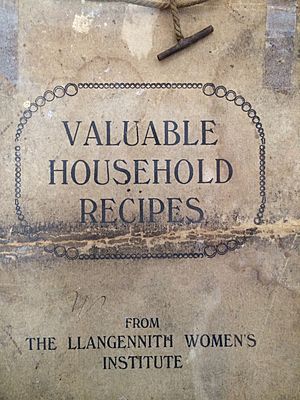Cuisine of Gower facts for kids
The cuisine of Gower, a peninsula in south Wales, is all about fresh food. It uses ingredients grown, raised, or gathered right there. For a long time, Gower was quite isolated. Poor roads and no trains meant people had to grow most of their own food. This made Gower very self-sufficient.
Over time, Gower people also developed their own way of speaking English, called the Gower dialect. They had unique traditions too, though many have now faded away. People on the peninsula worked in farming, fishing, weaving, and even coal mining or gathering cockles. With better roads and cars, Gower became a popular place for tourists. Many people now travel from Gower to work in the nearby city of Swansea. A lot of the fresh food from Gower farms is now sold at Swansea Market and local farmers' markets.
Contents
Gower's Food Story
In the 1700s, people in Gower grew crops like corn, hay, flax, and fruit. They also raised animals such as sheep, cattle, pigs, and geese. Many villages grew all their own food. Residents even paid a yearly fee to the local lord to have fishing rights.
For many centuries, land in south and west Gower was set up in an old system. Farmers had open fields and shared common land for animals to graze. This system meant people paid a "tithe" – giving a tenth of their lambs, wool, and grain as payment.
Later, new laws changed how land was owned, but Gower's common lands stayed the same. North and east Gower kept a traditional Welsh way of owning land, based on family groups. This system decided who could graze animals and farm. The Norman and Welsh parts of Gower were separated by common lands like Clyne Common and Cefn Bryn.
The land in Gower is made of limestone, coal, and Old Red Sandstone. A report from 1814 said that the limestone soil was excellent for farming. It was described as a brownish, rich soil that grew all kinds of grain and sweet grasses. Gower also has a mild climate because of the Gulf Stream near the coast. This means winters are often free of frost, especially in the southwest.
Fresh Vegetables
Because of its unique land and weather, Gower is famous for its root vegetables. These include potatoes, cauliflower, and swedes. Cauliflower needs a frost-free climate to grow well. The area around Rhossili is a big supplier of cauliflowers. Thousands of boxes of cauliflowers are sent from here to shops across the country in winter.
You can buy fresh Gower vegetables at local farmers' markets and Swansea Market. Farms like Nicholaston Farm, owned by the Beynon family, also sell fresh asparagus, beans, and peas.
Meat and Game
Gower is well known for its high-quality lamb. Sheep that graze on the sandstone areas, like Cefn Bryn, produce fine wool and tasty meat. The lamb that grazes on the salt marshes of the Burry Inlet is especially famous. These sheep eat salt marsh grasses, samphire, and other plants, which gives their meat a special flavor.
Welsh Black cattle are raised for beef. You can find them on the Penrice Estate near Oxwich. This beef is supplied to local restaurants. Welsh Black beef is becoming popular again. It's thought to be one of Britain's oldest cattle breeds, similar to those from before the Roman invasion.
Rabbits are common around the Gower coast. While living in Rhossili, chef Colin Pressdee created a dish called Rabbit Casserole with Faggots. The faggots (meatballs) make the dish hearty for hard-working locals.
You can buy meat and game at local butcher shops. Paul Tucker and Son in Penclawdd sell local beef, lamb (including salt marsh lamb), poultry, and pork. They also make their own bacon, faggots, and award-winning burgers. Howells is another Penclawdd butcher that supplies salt marsh lamb. Weobly Castle Farm also sells Gower salt-marsh lamb. In Swansea, the Gower butcher Hugh Philips has had a stall at Swansea Market since 1878. They get meat from their family farm in Gower and nearby farms. They specialize in Welsh lamb, seasonal salt-marsh lamb, and traditional beef breeds like the Welsh Black. They also make homemade sausages.
Fish and Seafood
Laverbread (Welsh: bara lawr) is made from a purplish-black seaweed found on Gower's beaches. It's more common in winter. Traditionally, it's boiled for hours until it becomes a thick puree. You can buy it at Swansea Market. If you gather it fresh, you can deep-fry it into tasty crisps. Other dishes include laverbread breakfast cake and laverbread with cockles. While some Gower laverbread is still made, larger amounts come from Scotland. A Gower breakfast might include bacon, cockles, laverbread, and baked eggs.
Crabbing (catching crabs and lobsters) was a traditional Gower skill. The best crabbers used only their hands to pull crabs from holes they knew well. A hook was only used for difficult crabs. Each crabber had their own area of rocks. They passed this knowledge down through their families. Gower is on the Bristol Channel, which has huge tides. This exposes large areas of rocks and sand at low tide. The layered limestone rocks provide many hiding spots for crabs and lobsters. The best crabs are found under ledges. When buying crabs, choose a smaller one that feels heavy for its size and has a firm shell. Crabs make good soup, fishcakes, or stews. You can buy crabs and lobsters at Swansea Market. Male lobsters are good for salads, while female lobsters are better for dishes with sauces because their roe (eggs) adds flavor.
North Gower is famous for cockles. Families from villages like Crofty and Penclawdd have been gathering cockles from the Burry Inlet for generations. The cooked cockles are sold in Swansea and are a specialty at Swansea Market. Cockles are gathered from the sand at low tide. Gatherers follow the tide, raking cockles out of the sand with a curved metal blade called a scrape. This work is done in all kinds of weather, sometimes starting as early as 3 am in summer.
In the past, donkeys pulled flat carts to collect cockles, then ponies, and now Land Rovers are used. Cockle gathering is regulated by a special order from 1965. There are two types: boiling cockles are smaller and cooked locally, while shell cockles are larger. Cockles need to be washed and cooked well, so it's best to buy them from a producer. Fresh cockles should be soaked in lightly salted water for 24 hours to clean themselves. A spoonful of wholemeal flour or oatmeal helps. Traditionally, cockles were part of a breakfast with Welsh bacon and eggs. Cockles can be used in many dishes, from Mediterranean to American, and they make a great chowder. Swansea holds a Cockle Festival every year in September, where chefs show how to cook with fresh Penclawdd cockles.
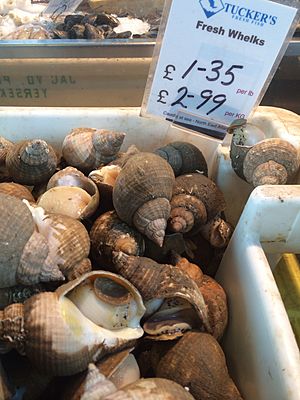
Oyster fisheries have been in South Wales since the time of Queen Elizabeth I. Two important oyster beds were in Swansea Bay. At one point, Mumbles had one of Europe's largest oyster fisheries. They exported millions of oysters every year. Fishing usually happened in winter. Oysters were a basic food for many Mumbles families and often the first food for Mumbles children. They were often fried in an omelette or with breadcrumbs. They could also be eaten in a Carpetbag steak, which is a thick steak filled with oysters and grilled. This old dish used to have lots of cheap oysters and less beef. William Ewart Gladstone visited Mumbles often and always ate oysters. The most common way to eat oysters was Oysters Fried with Bacon. This was often cooked on the oyster dredging boats. Over-fishing and pollution ended the industry in the 1930s, but oyster stocks are now growing back. A modern oyster starter is Gratin of Oysters with Herb Crust.
Prawns can be caught in summer and autumn in rock pools around the Welsh coast, including Gower. You can catch them with a push net when the tide goes out. A famous blind fisherman from Mumbles was very good at netting prawns. His portrait is in the Glynn Vivian Art Gallery in Swansea.
Swansea still has many small fishing boats. These boats go out for short, one-day trips and return with fresh fish. This fish is sold at Swansea Market and the fish docks. Mackerel visit in summer and autumn and are eaten fresh. They can be smoked, marinaded, or made into a pâté. You can catch them around the Gower coast. Sea Bass are beautiful fish that thrive in rough weather. They can be caught in the rocky gullies of Gower's headlands as they hunt for crabs. Fishing trawlers often catch lots of squid and cuttlefish in summer, which can be inexpensive. They can be grilled or stuffed.
You can find many fishmongers in Swansea Market. Coakley-Green opened in 1856, and Tucker's Fresh and Frozen Seafood has been there for three generations.
Sweet Fruit
Gower farms and small plots grow soft fruit during the summer. You can buy these at Farmers' markets. You can also pick your own fruit at some farms. At Scurlage Farm in Penmaen, visitors can pick their own strawberries. At Nicholaston Farm, also in Penmaen, you can pick raspberries, strawberries, gooseberries, and redcurrants. The Beynon family has owned Nicholaston Farm for five generations.
Cakes and Desserts
Gower fudge is a special fudge made in Penclawdd. It uses local ingredients, including Gwyr Gin. You can find it in shops across Gower or order it online.
Maddocks Cakes, run by Anthony and Pat Maddocks, are the main makers of Welsh cakes in Gower. They have a tea shop in Southgate, Pennard, which sells handmade Welsh cakes cooked on a bakestone using local ingredients. These are also available by mail order. Kate Jenkins, of Gower Cottage Brownies, uses fresh Gower free-range eggs in her brownies. These won an award in 2007. So Cocoa is the only independent chocolate shop in the area. It's in Mumbles and specializes in fancy chocolates, including those made in Wales.
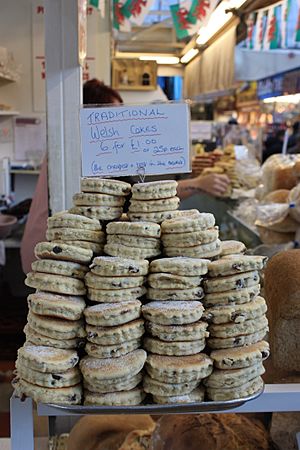
Cool Ice Cream
You can enjoy ice cream at Joe's Ice Cream Parlour, which has been making ice cream locally for 100 years. Forte's Ice Cream parlour at Bracelet Bay is the oldest ice cream parlour in Swansea and Gower.
Other ice cream parlours include Verdi's Ice Cream Parlour on Mumbles Promenade.
Farmers' Markets and Shops
Farmers' markets are held in several Gower villages:
- Llangennith (last Saturday of each month, April to September)
- Loughor (last Friday of each month)
- Mumbles (second Saturday of each month)
- Penclawdd (third Saturday of each month)
- Pennard (second Sunday of each month)
- Sketty (first Saturday of each month)
Crickton Farm in Llanrhidian has a farm shop selling vegetables and other produce. The Gower Wildflower and Local Produce Centre, run by Rachel and David Holland, has a cafe and sells local produce.
Great Places to Eat
The Fairyhill Hotel and Restaurant, near Reynoldston in Gower, is a 5-star hotel. It was one of the first restaurants in Britain to get all its ingredients from within 10 miles. This is easy because it's in the middle of Gower's rich farmlands and close to the sea. The restaurant also uses vegetables from its own garden and eggs from its own ducks.
Local Food Plans
Gower and Swansea have a project called Rural Swansea Action: Local Food for Local Markets. This project wants to understand what local farms and food businesses need. The goal is to help the rural economy grow, make local areas more successful, and build Gower's reputation as a place that produces high-quality food for local markets.
A survey in 2005 showed that most Gower residents knew about local produce. They said they would pay more for Gower food. Weekly Gower Farmers' markets, local farm shops, and a Gower brand were seen as ways to encourage sales.
Old Gower Traditions
On Mabsant, or Saint's Day, different Gower villages celebrated their patron saint. Each village had a traditional Mabsant dish. In Llangennith, it was whitepot, a mix of flour, milk, and currants baked in a brick oven. Rhossili's special dish was a type of plum pudding called a Bonny clobby. Llanmadog's specialty was a mutton pie made from chopped mutton and currants.
Traditional Gower weddings were called Bidding Weddings. A "bidder" would sing a formal invitation to guests. The night before the wedding, relatives would bring gifts of Currant loaves. These were sliced and sold at the wedding supper to young men. They would then give the slices to girls they liked. The girl with the most slices was named the Belle of the Ball. After the wedding, the supper included Tin-meat. This was mutton baked in a large tin with a pastry top. Guests bought their Tin-meat at the table. Portions were also given to anyone in the village who couldn't attend.
Souly Day was celebrated on November 12th. On November 1st, most Gower wives would bake Souly cakes. On the evening of November 12th, village children would visit neighbors and sing a special song:
Souly Souly, Christendom
Every good lady give me some
Give me some or give me none
Give me an answer and I'll be gone
If you haven't got a penny
a ha'penny will do.
If you haven't got a ha'penny
God bless you.
The children would receive a Souly cake or money. This custom likely comes from All Soul's Day.
Until the 1880s, Oystermouth celebrated September 1st with a Bread and Cheese Fair. Oyster boat owners would treat their crews to bread, cheese, and beer. There were also fun activities like punt races, diving, swimming, and greasy pole competitions. Children would collect oyster shells from visitors and build a grotto decorated with seaweed and lit by a candle inside.
Wassailing is a traditional Christmastime drinking ritual. The beginning of the Gower Wassail song goes like this:
A-wassail, a-wassail throughout all the town
Our cup it is white and our ale it is brown
Our wassail is made of the good ale and cake (too)
Some nutmeg and ginger, the best you can bake (do)
Our wassail is made of the elderberry bough
And so my good neighbours we'll drink unto thou
Besides all on earth, you have apples in store
Pray let us come in for it's cold by the door
Images for kids
-
Welsh Mountain sheep grazing at Rhossili
-
The Causeway, Cwm Ivy, is a sea wall built in 1638. It separates a freshwater marsh from a saltwater marsh. Cattle graze the freshwater marsh and sheep graze the saltwater marsh, which gives us the local Gower salt marsh lamb.
-
The limestone coast of south Gower east of Mewslade Bay. You can see the layers of rock and coves where crabs were once caught. Welsh Mountain sheep graze on the cliffs.



